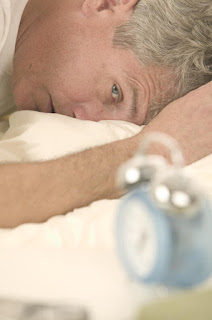Disruptions in sleep can be caused by a variety of issues, from teeth grinding (bruxism) to night terrors. When a person suffers from difficulty in sleeping with no obvious cause, it is referred to as insomnia.[1] In addition, sleep disorders may also cause sufferers to sleep excessively, a condition known as hypersomnia. Management of sleep disturbances that are secondary to mental, medical, or substance abuse disorders should focus on the underlying conditions.
Common disorders
The most common sleep disorders include:- Primary insomnia: Chronic difficulty in falling asleep and/or maintaining sleep when no other cause is found for these symptoms.
- Bruxism: Involuntarily grinding or clenching of the teeth while sleeping.
- Delayed sleep phase syndrome (DSPS): inability to awaken and fall asleep at socially acceptable times but no problem with sleep maintenance, a disorder of circadian rhythms. (Other such disorders are advanced sleep phase syndrome (ASPS), non-24-hour sleep-wake syndrome (Non-24), and irregular sleep wake rhythm, all much less common than DSPS, as well as the transient jet lag and shift work sleep disorder.)
- Hypopnea syndrome: Abnormally shallow breathing or slow respiratory rate while sleeping.
- Narcolepsy: Excessive daytime sleepiness (EDS) often culminating in falling asleep spontaneously but unwillingly at inappropriate times.
- Cataplexy: a sudden weakness in the motor muscles that can result in collapse to the floor.
- Night terror: Pavor nocturnus, sleep terror disorder: abrupt awakening from sleep with behavior consistent with terror.
- Parasomnias: Disruptive sleep-related events involving inappropriate actions during sleep; sleep walking and night-terrors are examples.
- Periodic limb movement disorder (PLMD): Sudden involuntary movement of arms and/or legs during sleep, for example kicking the legs. Also known as nocturnal myoclonus. See also Hypnic jerk, which is not a disorder.
- Rapid eye movement behavior disorder (RBD): Acting out violent or dramatic dreams while in REM sleep.
- Restless legs syndrome (RLS): An irresistible urge to move legs. RLS sufferers often also have PLMD
General principles of treatment
Treatments for sleep disorders generally can be grouped into four categories:
- behavioral/ psychotherapeutic treatmentsrehabilitation/management
- medications
- other somatic treatments
-


Medications and somatic treatments may provide the most rapid symptomatic relief from some sleep disturbances. Some disorders, such as narcolepsy, are best treated pharmacologically. Others, such as chronic and primary insomnia, may be more amenable to behavioral interventions, with more durable results.
Chronic sleep disorders in childhood, which affect some 70% of children with developmental or psychological disorders, are under-reported and under-treated. Sleep-phase disruption is also common among adolescents, whose school schedules are often incompatible with their natural circadian rhythm. Effective treatment begins with careful diagnosis using sleep diaries and perhaps sleep studies. Modifications in sleep hygiene may resolve the problem, but medical treatment is often warranted.
Special equipment may be required for treatment of several disorders such as obstructive apnea, the circadian rhythm disorders and bruxism. In these cases, when severe, an acceptance of living with the disorder, however well managed, is often necessary.
Some sleep disorders have been found to compromise glucose metabolism.
Sleep medicine


